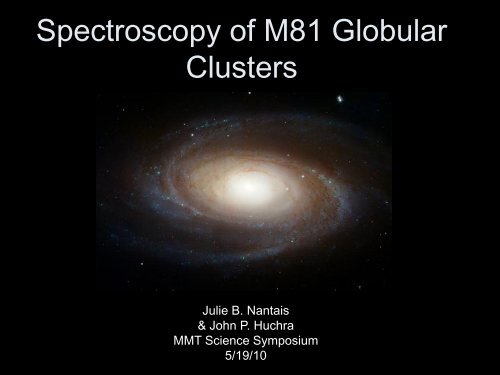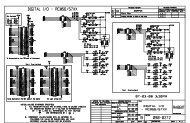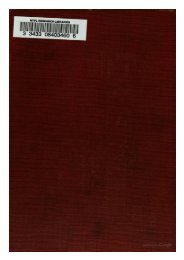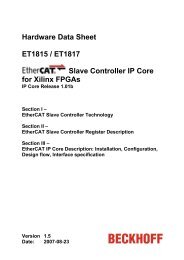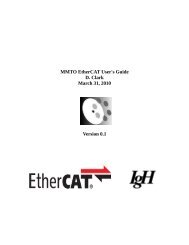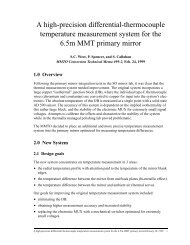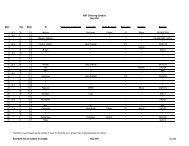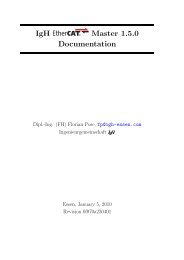Globular Clusters in M81
Globular Clusters in M81
Globular Clusters in M81
- No tags were found...
Create successful ePaper yourself
Turn your PDF publications into a flip-book with our unique Google optimized e-Paper software.
Spectroscopy of <strong>M81</strong> <strong>Globular</strong><strong>Clusters</strong>Julie B. Nantais& John P. HuchraMMT Science Symposium5/19/10
Galaxy Formation and <strong>Globular</strong><strong>Clusters</strong>• Questions: How did galaxies get to be different? Didall galaxies of similar mass and Hubble type form thesame way? To what extent are earliest formationprocesses and present galaxy properties related?• Old globular clusters (GCs) date back to earliest erasof galaxy formation and have simple age andmetallicity structure, allow<strong>in</strong>g them to serve as“fossils” of early galaxy formation• GCs are bright enough to study <strong>in</strong> most nearbygalaxies (out to tens of Mpc and more), and providemuch greater spatial detail than high-redshift galaxystudies
Why study GCs <strong>in</strong> <strong>M81</strong>?• GC systems (GCSs) of spiral galaxies <strong>in</strong> general(except for MW & M31) not yet well-studied• Similar <strong>in</strong> mass, Hubble type to MW & M31; helps usunderstand if MW & M31 are typical of early-typemassive spirals• Interactions with M82 have affected recent starformation history; may have also affected GC system• Very nearby (~3.5 Mpc), so GCs are bright, easy toobserve spectroscopically, easy to resolve with HSTor adaptive optics• Only 46 of expected 200+ GCs werespectroscopically confirmed (before this research)
Data and Analysis• Candidates identified <strong>in</strong> HST I-band survey, selectedto be extended so as to weed out foreground stars• Spectra taken with MMT (Mt. Hopk<strong>in</strong>s) Hectospec• Wavelength coverage 3700-9150Å, resolution ~5Å• Exposure times 60-160 m<strong>in</strong>utes• 151 useful spectra of GCs, galaxies, HIIs, and youngclusters (207 spectra total)• 74 GCs identified, 62 never previouslyspectroscopically confirmed, more than doubl<strong>in</strong>gnumber of confirmed GCs• Metallicities determ<strong>in</strong>ed via updated Brodie & Huchra(1990) method, described below
Metallicity Analysis Methodology• Update of Brodie & Huchra (1990) spectral <strong>in</strong>dexmetallicitycalibrations us<strong>in</strong>g Schiavon et al. (2005)GC spectra and Harris (1996) metallicities• Schiavon et al. spectra degraded to match resolutionof our spectra• 25 <strong>in</strong>dices calibrated: the 12 Brodie & Huchra (1990)<strong>in</strong>dices (8 of which have equivalents <strong>in</strong> Lick/IDS) plus13 <strong>in</strong>dices with Lick/IDS (Trager 1998) wavelengthdef<strong>in</strong>itions• 9 <strong>in</strong>dices chosen based on comb<strong>in</strong>ation of high S/N<strong>in</strong> our data and high correlation with metallicity: MgH,Mg2, Mgb, Fe52, Fe53, Fe54, G43, (4000 Å break),& CNR
<strong>M81</strong> GC Sample Spectra
<strong>M81</strong> Spectroscopy - Metallicity Histogram• Mean [Fe/H] =-1.06 0.07• Marg<strong>in</strong>al evidenceof bimodality: KMMpeaks -1.55 and-0.61 with P = 0.14• Nearly evenMR/MP split
<strong>M81</strong> Spectroscopy: GC Metallicity -Galaxy Lum<strong>in</strong>osity RelationB-bandK-band• <strong>M81</strong> consistent with GC metallicity - galaxy lum<strong>in</strong>osityrelation
<strong>M81</strong> Spectroscopy - GC Rotation CurvesAll Objects Individually30 Degree B<strong>in</strong>s• V r (deprojected) = 108 ± 22 km/s; 45% of peak HI rotationamplitude (240 km/s)• Velocity Dispersion = 145 km/s (V/ = 0.74)• Rotation-corrected = 128 km/s
<strong>M81</strong> Spectroscopy - GC Subpop. Rotation CurvesProjected RadiusMetallicity• Metal-rich (122 ± 18 km/s) and <strong>in</strong>ner (133 ± 40 km/s) clustersrotate strongly• Metal-poor clusters show marg<strong>in</strong>al signs of rotation (67 ± 38 km/s)
<strong>M81</strong> GC Metallicity Gradient<strong>M81</strong>M31Milky Way• H<strong>in</strong>t of metallicity gradient <strong>in</strong> overall GC system:-0.025 ± 0.020 dex/kpc• Stronger metallicity gradient among MP clustersalone: -0.031 ± 0.012 dex/kpc
Spiral Galaxy GC Comparisons:Metallicity• M31 and MW have clearly bimodal GC distributions;<strong>M81</strong> probably bimodal as well• M31, MW, & <strong>M81</strong> metallicity peaks similar, and allconsistent with GC metallicity-galaxy lum<strong>in</strong>osityrelations for MR and MP peaks• M31, MW, & <strong>M81</strong> all show signs of metallicitygradients as a function of galactocentric distance
Spiral Galaxy GCComparisons: K<strong>in</strong>ematics• K<strong>in</strong>ematic subpopulations exist <strong>in</strong> MW, M31, <strong>M81</strong>,possibly even M33 (Chandar et al. 2002), but noevidence of them <strong>in</strong> M104 (Bridges et al. 2007)• In MW, MR clusters rotate significantly, MP clustersrotate little; <strong>in</strong> M31, both rotate (but with lower V/ forMP)• In <strong>M81</strong>, rotation pattern similar to, but slightlystronger than, MW
Summary of Results• 62 new <strong>M81</strong> GCs spectroscopically confirmed, morethan doubl<strong>in</strong>g known <strong>M81</strong> GC sample• Marg<strong>in</strong>al evidence for bimodal [Fe/H] distribution <strong>in</strong><strong>M81</strong>, with peaks similar to MW & M31• <strong>M81</strong> consistent with GC metallicity vs. galaxylum<strong>in</strong>osity relation• <strong>M81</strong> GCs <strong>in</strong> general, and especially MR & <strong>in</strong>nerones, show evidence of rotation• Evidence for Metallicity Gradient among MP <strong>M81</strong>GCs• Metallicity-lum<strong>in</strong>osity relations & MP metallicitygradient suggest l<strong>in</strong>k between early GC formationprocesses & gravitational potential well of eventualhost galaxy
Acknowledgments• Collaborator and thesis advisor: John Huchra• Much helpful feedback from J. Strader• Supported by NASA grant GO-10250, NSF grantAST 0507729, GALEX Guest Observer grantNNG06GD33G


